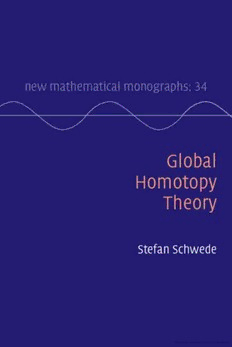Table Of ContentGlobalHomotopyTheory
Equivariant homotopy theory started from geometrically motivated questions about
symmetriesofmanifolds.Severalimportantequivariantphenomenaoccurnotjustfor
a particular group, but in a uniform way for all groups. Prominent examples include
stable homotopy, K-theory or bordism. Global equivariant homotopy theory studies
such uniform phenomena, i.e., universal symmetries encoded by simultaneous and
compatibleactionsofallcompactLiegroups.
Thisbookintroducesgraduatestudentsandresearcherstoglobalequivarianthomo-
topy theory. The framework is based on the new notion of global equivalences for
orthogonalspectra,amuchfinernotionofequivalencethanistraditionallyconsidered.
Thetreatmentislargelyself-containedandcontainsmanyexamples,makingitsuitable
as a textbook for an advanced graduate class. At the same time, the book is a
comprehensiveresearchmonographwithdetailedcalculationsthatrevealtheintrinsic
beautyofglobalequivariantphenomena.
Stefan Schwede is Professor in the Mathematical Institute at the University of
Bonn. His main area of expertise is algebraic topology, specifically stable homotopy
theory.
NEW MATHEMATICAL MONOGRAPHS
EditorialBoard
Be´laBolloba´s,WilliamFulton,FrancesKirwan,
PeterSarnak,BarrySimon,BurtTotaro
AllthetitleslistedbelowcanbeobtainedfromgoodbooksellersorfromCambridgeUniversity
Press.Foracompleteserieslistingvisitwww.cambridge.org/mathematics.
1. M.CabanesandM.EnguehardRepresentationTheoryofFiniteReductiveGroups
2. J.B.GarnettandD.E.MarshallHarmonicMeasure
3. P.CohnFreeIdealRingsandLocalizationinGeneralRings
4. E.BombieriandW.GublerHeightsinDiophantineGeometry
5. Y.J.IoninandM.S.ShrikhandeCombinatoricsofSymmetricDesigns
6. S.Berhanu,P.D.CordaroandJ.HounieAnIntroductiontoInvolutiveStructures
7. A.ShlapentokhHilbert’sTenthProblem
8. G.MichlerTheoryofFiniteSimpleGroupsI
9. A.BakerandG.Wu¨stholzLogarithmicFormsandDiophantineGeometry
10. P.KronheimerandT.MrowkaMonopolesandThree-Manifolds
11. B.Bekka,P.delaHarpeandA.ValetteKazhdan’sProperty(T)
12. J.NeisendorferAlgebraicMethodsinUnstableHomotopyTheory
13. M.GrandisDirectedAlgebraicTopology
14. G.MichlerTheoryofFiniteSimpleGroupsII
15. R.SchertzComplexMultiplication
16. S.BlochLecturesonAlgebraicCycles(2ndEdition)
17. B.Conrad,O.GabberandG.PrasadPseudo-reductiveGroups
18. T.DownarowiczEntropyinDynamicalSystems
19. C.SimpsonHomotopyTheoryofHigherCategories
20. E.FricainandJ.MashreghiTheTheoryofH(b)SpacesI
21. E.FricainandJ.MashreghiTheTheoryofH(b)SpacesII
22. J.Goubault-LarrecqNon-HausdorffTopologyandDomainTheory
23. J.S´niatyckiDifferentialGeometryofSingularSpacesandReductionofSymmetry
24. E.RiehlCategoricalHomotopyTheory
25. B.A.MunsonandI.Volic´CubicalHomotopyTheory
26. B.Conrad,O.GabberandG.PrasadPseudo-reductiveGroups(2ndEdition)
27. J.Heinonen,P.Koskela,N.ShanmugalingamandJ.T.TysonSobolevSpacesonMetric
MeasureSpaces
28. Y.-G.OhSymplecticTopologyandFloerHomologyI
29. Y.-G.OhSymplecticTopologyandFloerHomologyII
30. A.BobrowskiConvergenceofOne-ParameterOperatorSemigroups
31. K.CostelloandO.GwilliamFactorizationAlgebrasinQuantumFieldTheoryI
32. J.-H.EvertseandK.Gyo¨ryDiscriminantEquationsinDiophantineNumberTheory
Global Homotopy Theory
STEFAN SCHWEDE
RheinischeFriedrich-Wilhelms-Universita¨tBonn
UniversityPrintingHouse,CambridgeCB28BS,UnitedKingdom
OneLibertyPlaza,20thFloor,NewYork,NY10006,USA
477WilliamstownRoad,PortMelbourne,VIC3207,Australia
314–321,3rdFloor,Plot3,SplendorForum,JasolaDistrictCentre,
NewDelhi–110025,India
79AnsonRoad,#06-04/06,Singapore079906
CambridgeUniversityPressispartoftheUniversityofCambridge.
ItfurtherstheUniversity’smissionbydisseminatingknowledgeinthepursuitof
education,learning,andresearchatthehighestinternationallevelsofexcellence.
www.cambridge.org
Informationonthistitle:www.cambridge.org/9781108425810
DOI:10.1017/9781108349161
©StefanSchwede2018
Thispublicationisincopyright.Subjecttostatutoryexception
andtotheprovisionsofrelevantcollectivelicensingagreements,
noreproductionofanypartmaytakeplacewithoutthewritten
permissionofCambridgeUniversityPress.
Firstpublished2018
PrintedandboundinGreatBritainbyClaysLtd,ElcografS.p.A.
AcataloguerecordforthispublicationisavailablefromtheBritishLibrary
ISBN978-1-108-42581-0Hardback
CambridgeUniversityPresshasnoresponsibilityforthepersistenceoraccuracyof
URLsforexternalorthird-partyinternetwebsitesreferredtointhispublication
anddoesnotguaranteethatanycontentonsuchwebsitesis,orwillremain,
accurateorappropriate.
Contents
Preface pagevii
1 Unstableglobalhomotopytheory 1
1.1 Orthogonalspacesandglobalequivalences 2
1.2 Globalmodelstructurefororthogonalspaces 31
1.3 Monoidalstructures 54
1.4 Globalfamilies 64
1.5 Equivarianthomotopysets 77
2 Ultra-commutativemonoids 92
2.1 Globalmodelstructure 94
2.2 Globalpowermonoids 110
2.3 Examples 133
2.4 GlobalformsofBO 156
2.5 Globalgroupcompletionandunits 186
3 Equivariantstablehomotopytheory 227
3.1 Equivariantorthogonalspectra 228
3.2 TheWirthmu¨llerisomorphismandtransfers 261
3.3 Geometricfixedpoints 288
3.4 Thedoublecosetformula 305
3.5 Products 332
4 Globalstablehomotopytheory 348
4.1 Orthogonalspectraasglobalhomotopytypes 349
4.2 Globalfunctors 367
4.3 Globalmodelstructuresfororthogonalspectra 385
4.4 Triangulatedglobalstablehomotopycategories 409
4.5 Changeoffamilies 430
5 Ultra-commutativeringspectra 461
5.1 Poweroperations 462
v
vi Contents
5.2 Comonadicdescriptionofglobalpowerfunctors 481
5.3 Examples 506
5.4 Globalmodelstructure 524
6 GlobalThomandK-theoryspectra 543
6.1 GlobalThomspectra 544
6.2 Equivariantbordism 584
6.3 ConnectiveglobalK-theory 626
6.4 PeriodicglobalK-theory 661
AppendixA Compactlygeneratedspaces 687
AppendixB Equivariantspaces 735
AppendixC Enrichedfunctorcategories 793
References 809
Indexofsymbols 819
Index 822
Preface
Equivariant stable homotopy theory has a long tradition, starting from
geometrically motivated questions about symmetries of manifolds. The
homotopy-theoretic foundations of the subject were laid by tom Dieck, Se-
gal and May and their students and collaborators in the 1970s, and over the
intervening decades equivariant stable homotopy theory has been very use-
fulforsolvingcomputationalandconceptualproblemsinalgebraictopology,
geometrictopologyandalgebraicK-theory.Variousimportantequivariantthe-
ories naturally exist not just for a particular group, but in a uniform way for
all groups in a specific class. Prominent examples of this are equivariant sta-
blehomotopy,equivariantK-theoryorequivariantbordism.Globalequivariant
homotopytheorystudiessuchuniformphenomena,i.e.,theadjective‘global’
referstosimultaneousandcompatibleactionsofallcompactLiegroups.
This book introduces a new context for global homotopy theory. Various
ways of providing a home for global stable homotopy types have previously
beenexploredin[100,Ch.II],[68,Sec.5],[18]and[19].Weuseadifferentap-
proach:weworkwiththewell-knowncategoryoforthogonalspectra,butuse
anotionofequivalence,theglobalequivalence,whichismuchfinerthanwhat
istraditionallyconsidered.Thebasicunderlyingobservationisthatanorthog-
onal spectrum gives rise to an orthogonalG-spectrum for every compact Lie
groupG, and the fact that all these individual equivariant objects come from
oneorthogonalspectrumimplicitlyencodesstrongcompatibilityconditionsas
thegroupGvaries.AnorthogonalspectrumthushasG-equivarianthomotopy
groupsforeverycompactLiegroup,andaglobalequivalenceisamorphism
oforthogonalspectrathatinducesisomorphismsforallequivarianthomotopy
groupsforallcompactLiegroups(basedon‘completeG-universes’,compare
Definition4.1.3).
The structure of the equivariant homotopy groups of an orthogonal spec-
trum gives an idea of the information encoded in a global homotopy type in
our sense: the equivariant homotopy groups πG(X) are contravariantly func-
k
vii
viii Preface
torialforcontinuousgrouphomomorphisms(‘restrictionmaps’),andtheyare
covariantlyfunctorialforinclusionsofclosedsubgroups(‘transfermaps’).The
restrictionandtransfermapsenjoyvarioustransitivitypropertiesandinteract
via a double coset formula. This kind of algebraic structure has been studied
before under different names, e.g., ‘global Mackey functor’, ‘inflation func-
tor’, .... From a purely algebraic perspective, there are various parameters
herethatonecanvary,namelytheclassofgroupstowhichavalueisassigned
andtheclassesofhomomorphismstowhichrestrictionmapsortransfermaps
areassigned,andlotsofvariationshavebeenexplored.However,thedecision
toworkwithorthogonalspectraandequivarianthomotopygroupsoncomplete
universesdictatesacanonicalchoice:weproveinTheorem4.2.6thatthealge-
braofnaturaloperationsbetweentheequivarianthomotopygroupsoforthog-
onal spectra is freely generated by restriction maps along continuous group
homomorphisms and transfer maps along closed subgroup inclusion, subject
toexplicitlyunderstoodrelations.
WedefinetheglobalstablehomotopycategoryGH bylocalizingthecate-
gory of orthogonal spectra at the class of global equivalences. Every global
equivalenceisinparticularanon-equivariantstableequivalence,sothereisa
‘forgetful’ functor U: GH −→ SH on localizations, where SH denotes the
traditional non-equivariant stable homotopy category. By Theorem 4.5.1 this
forgetfulfunctorhasaleftadjoint LandarightadjointR,bothfullyfaithful,
whichparticipateinarecollementoftriangulatedcategories:
(cid:4)(cid:4) i∗ (cid:4)(cid:4) L
GH+ i∗ (cid:2)(cid:2)GH U (cid:2)(cid:2)SH .
(cid:3)(cid:3) (cid:3)(cid:3)
i! R
HereGH+denotesthefullsubcategoryoftheglobalstablehomotopycategory
spannedbytheorthogonalspectrathatarestablycontractibleinthetraditional,
non-equivariantsense.
Theglobalspherespectrumandsuspensionspectraareintheimageofthe
left adjoint (Example 4.5.11). Global Borel cohomology theories are the im-
age of the right adjoint (Example 4.5.19). The ‘natural’ global versions of
Eilenberg–MacLanespectra(Construction5.3.8),Thomspectra(Section6.1),
ortopologicalK-theoryspectra(Sections6.3and6.4)arenotintheimageof
eitherofthetwoadjoints.PeriodicglobalK-theory,however,isrightinduced
fromfinitecyclicgroups,i.e.,intheimageoftheanalogousrightadjointfrom
anintermediateglobalhomotopycategoryGH basedonfinitecyclicgroups
cyc
(Example6.4.27).
Looking at orthogonal spectra through the eyes of global equivalences is
like using a prism: the latter breaks up white light into a spectrum of colors,
Preface ix
andglobalequivalencessplitatraditional,non-equivarianthomotopytypeinto
manydifferentglobalhomotopytypes.Thefirstexampleofthisphenomenon
that we will encounter refines the classifying space of a compact Lie group
G.Ontheonehand,thereistheconstantorthogonalspacewithvalueanon-
equivariantmodelfor BG;andthereistheglobalclassifyingspace B G (see
gl
Definition1.1.27).Theglobalclassifyingspaceisanalogoustothegeometric
classifyingspaceofalinearalgebraicgroupinmotivichomotopytheory[123,
4.2],anditisthecounterparttothestackofG-principalbundlesintheworld
ofstacks.
Anothergoodexample isthesplittingupofthenon-equivariant homotopy
type of the classifying space of the infinite orthogonal group. Again there is
the constant orthogonal space with value BO, the Grassmannian model BO
(Example 2.4.1), a different Grassmannian model bO (Example 2.4.18), the
bar construction model B◦O (Example 2.4.14), and finally a certain ‘cofree’
orthogonalspaceR(BO).TheorthogonalspacebOisalsoahomotopycolimit,
asngoestoinfinity,oftheglobalclassifyingspacesB O(n).Wediscussthese
gl
differentglobalformsof BOinsomedetailinSection2.4,andtheassociated
ThomspectrainSection6.1.
In the stable global world, every non-equivariant homotopy type has two
extremeglobalrefinements,the‘leftinduced’(theglobalanalogofaconstant
orthogonalspace,seeExample4.5.10)andthe‘rightinduced’globalhomotopy
type (representing Borel cohomology theories, see Example 4.5.19). Many
important stable homotopy types have other natural global forms. The non-
equivariant Eilenberg–MacLane spectrum of the integers has a ‘free abelian
groupfunctor’model(Construction5.3.8),andanotherincarnationistheEilen-
berg–MacLanespectrumoftheconstantglobalfunctorwithvalueZ(Remark
4.4.12).ThesetwoglobalrefinementsoftheintegralEilenberg–MacLanespec-
trum agree on finite groups, but differ for compact Lie groups of positive di-
mensions.
Asalreadyindicated,thereisagreatvarietyoforthogonalThomspectra,in
real(orunoriented)flavorsasmOandMO,ascomplex(orunitary)versions
mU and MU, and there are periodic versions mOP, MOP, mUP and MUP
ofthese;wediscussthesespectrainSection6.1.Thetheoriesrepresentedby
mO and mU have the closest ties to geometry; for example, the equivariant
homotopy groups of mO receive Thom–Pontryagin maps from equivariant
bordismrings,andtheseareisomorphismsforproductsoffinitegroupsandtori
(compareTheorem6.2.33).ThetheoriesrepresentedbyMOaretomDieck’s
homotopicalequivariantbordism,isomorphicto‘stableequivariantbordism’.
Connective topological K-theory also has two fairly natural global refine-
ments, in addition to the left and right induced ones. The ‘orthogonal sub-
space’ model ku (Construction 6.3.9) represents connective equivariant

